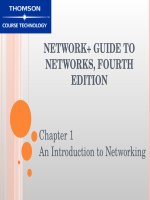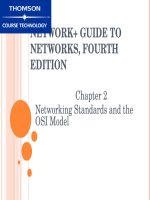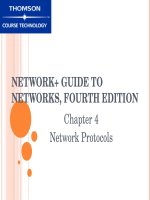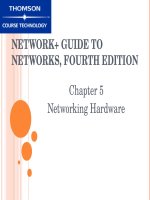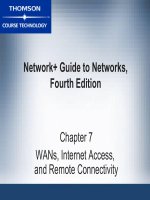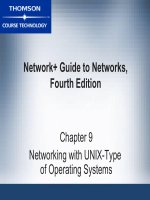Guide to network essentials 4th chapter 01
Bạn đang xem bản rút gọn của tài liệu. Xem và tải ngay bản đầy đủ của tài liệu tại đây (318.48 KB, 53 trang )
Chapter 1:
Introduction to Networks
and Networking Concepts
Learning Objectives
Understand basic networked communications
and services
Identify essential network components
Describe the benefits of networking
Understand and compare peer-to-peer and
server-based networks
Apply your knowledge when selecting an appropriate
network type for small business use
Suggest possible redesigns for a small but
expanding network
Guide to Networking Essent
2
What is Networking?
Connecting computers to share information and
resources
Complex and varied technology
Many choices for physical connections and
related software
Guide to Networking Essent
3
Networking Fundamentals
As simple as two computers connected with a
cable that can transmit data
Allows users to share data quickly and efficiently
Access to shared peripheral devices such as
printers, scanners, and fax machines
Guide to Networking Essent
4
Advantages of Networks
Allow groups of users to exchange information
and share data
Allow easy and efficient communication among
individuals, including electronic mail (e-mail)
Device sharing can reduce costs
Guide to Networking Essent
5
Standalone Computer and a
“Sneakernet”
Standalone computer
Single computer not
attached to a network
Cannot match power and
convenience of network
“Sneakernet”
Passing floppy disk from
machine to machine
Old alternative to
networking
Guide to Networking Essent
6
Sharing Resources on a Simple
Network
Networking computers
allows them to:
Share data
Access shared printer
and other equipment
Guide to Networking Essent
7
Local Area Networks (LANs) and
Internetworks
Early networks – custom-built, expensive,
severe restrictions
Early Ethernet – no more than 30 users with
total span of 607 feet
Local area network (LAN) – works within limited
geographic area
Building
block for constructing larger networks, called
internetworks
Internetwork – network 100 or more computers
at distances in excess of 1000 feet
Guide to Networking Essent
8
Wide Area Networks (WANs) and the
Internet
Wide area network (WAN) – spans distances
measured in miles; links two or more separate
LANS
Metropolitan area network (MAN) – uses WAN
technology to interconnect LANs within a specific
geographic region
Internet – global WAN internetwork; includes
millions of machines and users worldwide
Guide to Networking Essent
9
A Networking Lexicon
Must understand specialized networking vocabulary,
including
Server — shares resources across network, typically with
more central processing unit (CPU) power and storage
capacity than other computers
Client — accesses shared resources
Request-response — client requests information; server
responds by providing information
Client-server relationship — client makes a request to
the server, and the server responds with requested data
Peer-to-peer — computers share and request resources
from one another
Guide to Networking Essent
10
Client-Server Relationship
Guide to Networking Essent
11
Network Medium Carries Network
Messages
Computers share access to common network
medium that carries signals from one computer to
another
Medium may be physical cable, such as twisted
pair, coaxial, or fiber-optic
Medium may be wireless
Physical interface to medium is usually network
interface card (NIC) or network adapter
Kind of medium dictates type of connector and
limits number and type of devices as well as
distance a single LAN can span
Guide to Networking Essent
12
Network Protocols
Network protocols – a common set of rules
Define how to interpret signals, identify individual
computers, initiate and end networked communication,
and manage information exchange across network
medium
Include TCP/IP, NetBEUI, IPX/SPX, and NWLink
Guide to Networking Essent
13
Network Software
Network software issues requests and responses
Network operating system (NOS) controls which
computers and users access network resources
Include both client and server components
Popular NOSs include Windows Server 2003, Windows
XP, Windows 2000, Windows NT, and Novell NetWare
Network applications access the network
Include e-mail programs, Web browsers, and networkoriented utilities
Guide to Networking Essent
14
Network Services
Services include file and print services,
file-sharing, e-mail, and other capabilities
Network communications are layered
Network applications use NOS or client networking
software to get network protocol to access medium
Medium exchanges information with other computers
Figure 1-4 shows layers of networking process
Simulation 1-1 shows animated depiction of the
layered networking process
Guide to Networking Essent
15
Layers of the Networking
Process
Guide to Networking Essent
16
Network Types
Two major types of networks
Peer-to-peer
Client/Server
(also called server-based)
Guide to Networking Essent
17
Peer-to-Peer Networking
Peers with no centralized control over shared resources
Can share resources with any other computer on
network
No computer has higher access priority
No computer has more responsibility to provide or
shared resources
Figure 1-5 shows typical peer-to-peer network
Guide to Networking Essent
18
Peer-to-Peer Network
Guide to Networking Essent
19
Peer-to-Peer Networking
Advantages
Easy to install and configure
No dedicated server
Users control own shared resources
Inexpensive to purchase and operate
No additional equipment or software
No dedicated administrators
Works best with 10 or fewer users
Guide to Networking Essent
20
Peer-to-Peer Networking
Disadvantages
Security applies to single resource at a time
Users may have many different passwords
Must back up each machine individually
Machine sharing resources may suffers
reduced performance
No centralized organization scheme to locate
or control access to data
Does not usually work well with more than
10 users
Guide to Networking Essent
21
Server-Based Networks
Server responds to client requests
Figure 1-6 shows a typical server-based network
Provide centralized control over resources
Servers require faster CPUs, more memory,
larger disk drives, and extra peripherals such as
tape drives
May be dedicated, handling only requests from
client communities
Guide to Networking Essent
22
Server-Based Networks
(continued)
Guide to Networking Essent
23
Server-Based Networks
(continued)
One or more servers may do centralized verification
of user accounts and passwords
Novell and Windows servers use a directory service
Checks
account names and passwords against database
Manage shared resources
Windows 2000/2003 calls it Active Directory
Novell NetWare calls it Novell Directory Services (NDS)
Guide to Networking Essent
24
Server-Based Networks
(continued)
Easier to scale
May handle thousands of users
Guide to Networking Essent
25

